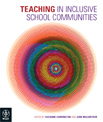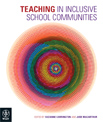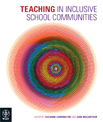Chapter 1 Towards an inclusive education for all
- Buy your e-book here
-
Student Self-Study Activities
-
Video Case
-
Curriculum Connections
- Australian Curriculum Assessment and Reporting Authority (ACARA)
- Australian Institute for Teaching and School Leaderhsip (AITSL)
- Principals Australia
- ACT Department of Education and Training
- DECS South Australia
- K-10 Syllabus (Department of Education and Training Western Australia)
- Northern Territory Department of Education & Training
- NSW Curriculum Support
- Queensland Studies Authority
- Tasmanian Department of Education
- Victorian Essential Learnings Standards
- The New Zealand Curriculum Online
- The Ministry of Education
- Education Counts
- Harvard Thinking Routines
- Inclusion Press
- Inclusive Schools Network
- Centre for Studies on Inclusive Education
- Include: Inclusion through skills development
-
Inclusion Reflection
Chapter 2 The development of the inclusive education movement
- Buy your e-book here
-
Student Self-Study Activities
-
Video Case
-
Curriculum Connections
- Australian Curriculum Assessment and Reporting Authority (ACARA)
- Australian Institute for Teaching and School Leaderhsip (AITSL)
- Principals Australia
- ACT Department of Education and Training
- DECS South Australia
- K-10 Syllabus (Department of Education and Training Western Australia)
- Northern Territory Department of Education & Training
- NSW Curriculum Support
- Queensland Studies Authority
- Tasmanian Department of Education
- Victorian Essential Learnings Standards
- The New Zealand Curriculum Online
- The Ministry of Education
- Education Counts
- Harvard Thinking Routines
- Inclusion Press
- Inclusive Schools Network
- Centre for Studies on Inclusive Education
- Include: Inclusion through skills development
-
Inclusion Reflection
Chapter 3 Inclusion and social justice: teachers as agents of change
- Buy your e-book here
-
Student Self-Study Activities
-
Video Case
-
Curriculum Connections
- Australian Curriculum Assessment and Reporting Authority (ACARA)
- Australian Institute for Teaching and School Leaderhsip (AITSL)
- Principals Australia
- ACT Department of Education and Training
- DECS South Australia
- K-10 Syllabus (Department of Education and Training Western Australia)
- Northern Territory Department of Education & Training
- NSW Curriculum Support
- Queensland Studies Authority
- Tasmanian Department of Education
- Victorian Essential Learnings Standards
- The New Zealand Curriculum Online
- The Ministry of Education
- Education Counts
- Harvard Thinking Routines
- Inclusion Press
- Inclusive Schools Network
- Centre for Studies on Inclusive Education
- Include: Inclusion through skills development
-
Inclusion Reflection
Chapter 4 Ethics in inclusive education
- Buy your e-book here
-
Student Self-Study Activities
-
Video Case
-
Curriculum Connections
- Australian Curriculum Assessment and Reporting Authority (ACARA)
- Australian Institute for Teaching and School Leaderhsip (AITSL)
- Principals Australia
- ACT Department of Education and Training
- DECS South Australia
- K-10 Syllabus (Department of Education and Training Western Australia)
- Northern Territory Department of Education & Training
- NSW Curriculum Support
- Queensland Studies Authority
- Tasmanian Department of Education
- Victorian Essential Learnings Standards
- The New Zealand Curriculum Online
- The Ministry of Education
- Education Counts
- Harvard Thinking Routines
- Inclusion Press
- Inclusive Schools Network
- Centre for Studies on Inclusive Education
- Include: Inclusion through skills development
-
Inclusion Reflection
Chapter 5 Large metropolitan and outer suburban school communities
- Buy your e-book here
-
Student Self-Study Activities
-
Video Case
-
Curriculum Connections
- Australian Curriculum Assessment and Reporting Authority (ACARA)
- Australian Institute for Teaching and School Leaderhsip (AITSL)
- Principals Australia
- ACT Department of Education and Training
- DECS South Australia
- K-10 Syllabus (Department of Education and Training Western Australia)
- Northern Territory Department of Education & Training
- NSW Curriculum Support
- Queensland Studies Authority
- Tasmanian Department of Education
- Victorian Essential Learnings Standards
- The New Zealand Curriculum Online
- The Ministry of Education
- Education Counts
- Harvard Thinking Routines
- Inclusion Press
- Inclusive Schools Network
- Centre for Studies on Inclusive Education
- Include: Inclusion through skills development
-
Inclusion Reflection
Chapter 6 Education and Aboriginal communities in Australia
- Buy your e-book here
-
Student Self-Study Activities
-
Video Case
-
Curriculum Connections
- Australian Curriculum Assessment and Reporting Authority (ACARA)
- Australian Institute for Teaching and School Leaderhsip (AITSL)
- Principals Australia
- ACT Department of Education and Training
- DECS South Australia
- K-10 Syllabus (Department of Education and Training Western Australia)
- Northern Territory Department of Education & Training
- NSW Curriculum Support
- Queensland Studies Authority
- Tasmanian Department of Education
- Victorian Essential Learnings Standards
- The New Zealand Curriculum Online
- The Ministry of Education
- Education Counts
- Harvard Thinking Routines
- Inclusion Press
- Inclusive Schools Network
- Centre for Studies on Inclusive Education
- Include: Inclusion through skills development
-
Inclusion Reflection
Chapter 7 Education and Maori communities in Aotearoa/New Zealand
- Buy your e-book here
-
Student Self-Study Activities
-
Curriculum Connections
- Australian Curriculum Assessment and Reporting Authority (ACARA)
- Australian Institute for Teaching and School Leaderhsip (AITSL)
- Principals Australia
- ACT Department of Education and Training
- DECS South Australia
- K-10 Syllabus (Department of Education and Training Western Australia)
- Northern Territory Department of Education & Training
- NSW Curriculum Support
- Queensland Studies Authority
- Tasmanian Department of Education
- Victorian Essential Learnings Standards
- The New Zealand Curriculum Online
- The Ministry of Education
- Education Counts
- Harvard Thinking Routines
- Inclusion Press
- Inclusive Schools Network
- Centre for Studies on Inclusive Education
- Include: Inclusion through skills development
-
Inclusion Reflection
Chapter 8 Naming or creating a problem? The misuse of labels
- Buy your e-book here
-
Student Self-Study Activities
-
Video Case
-
Curriculum Connections
- Australian Curriculum Assessment and Reporting Authority (ACARA)
- Australian Institute for Teaching and School Leaderhsip (AITSL)
- Principals Australia
- ACT Department of Education and Training
- DECS South Australia
- K-10 Syllabus (Department of Education and Training Western Australia)
- Northern Territory Department of Education & Training
- NSW Curriculum Support
- Queensland Studies Authority
- Tasmanian Department of Education
- Victorian Essential Learnings Standards
- The New Zealand Curriculum Online
- The Ministry of Education
- Education Counts
- Harvard Thinking Routines
- Inclusion Press
- Inclusive Schools Network
- Centre for Studies on Inclusive Education
- Include: Inclusion through skills development
-
Inclusion Reflection
Chapter 9 Partnership and collaboration with students, families and colleagues
- Buy your e-book here
-
Student Self-Study Activities
-
Video Case
-
Curriculum Connections
- Australian Curriculum Assessment and Reporting Authority (ACARA)
- Australian Institute for Teaching and School Leaderhsip (AITSL)
- Principals Australia
- ACT Department of Education and Training
- DECS South Australia
- K-10 Syllabus (Department of Education and Training Western Australia)
- Northern Territory Department of Education & Training
- NSW Curriculum Support
- Queensland Studies Authority
- Tasmanian Department of Education
- Victorian Essential Learnings Standards
- The New Zealand Curriculum Online
- The Ministry of Education
- Education Counts
- Harvard Thinking Routines
- Inclusion Press
- Inclusive Schools Network
- Centre for Studies on Inclusive Education
- Include: Inclusion through skills development
-
Inclusion Reflection
Chapter 10 Students' social participation
- Buy your e-book here
-
Student Self-Study Activities
-
Video Case
-
Curriculum Connections
- Australian Curriculum Assessment and Reporting Authority (ACARA)
- Australian Institute for Teaching and School Leaderhsip (AITSL)
- Principals Australia
- ACT Department of Education and Training
- DECS South Australia
- K-10 Syllabus (Department of Education and Training Western Australia)
- Northern Territory Department of Education & Training
- NSW Curriculum Support
- Queensland Studies Authority
- Tasmanian Department of Education
- Victorian Essential Learnings Standards
- The New Zealand Curriculum Online
- The Ministry of Education
- Education Counts
- Harvard Thinking Routines
- Inclusion Press
- Inclusive Schools Network
- Centre for Studies on Inclusive Education
- Include: Inclusion through skills development
-
Inclusion Reflection
Chapter 11 Curriculum, assessment, teaching and learning for all
- Buy your e-book here
-
Student Self-Study Activities
-
Video Case
-
Curriculum Connections
- Australian Curriculum Assessment and Reporting Authority (ACARA)
- Australian Institute for Teaching and School Leaderhsip (AITSL)
- Principals Australia
- ACT Department of Education and Training
- DECS South Australia
- K-10 Syllabus (Department of Education and Training Western Australia)
- Northern Territory Department of Education & Training
- NSW Curriculum Support
- Queensland Studies Authority
- Tasmanian Department of Education
- Victorian Essential Learnings Standards
- The New Zealand Curriculum Online
- The Ministry of Education
- Education Counts
- Harvard Thinking Routines
- Inclusion Press
- Inclusive Schools Network
- Centre for Studies on Inclusive Education
- Include: Inclusion through skills development
-
Inclusion Reflection
Chapter 12 Interprofessional practice as a model for teacher and classroom support
- Buy your e-book here
-
Student Self-Study Activities
-
Curriculum Connections
- Australian Curriculum Assessment and Reporting Authority (ACARA)
- Australian Institute for Teaching and School Leaderhsip (AITSL)
- Principals Australia
- ACT Department of Education and Training
- DECS South Australia
- K-10 Syllabus (Department of Education and Training Western Australia)
- Northern Territory Department of Education & Training
- NSW Curriculum Support
- Queensland Studies Authority
- Tasmanian Department of Education
- Victorian Essential Learnings Standards
- The New Zealand Curriculum Online
- The Ministry of Education
- Education Counts
- Harvard Thinking Routines
- Inclusion Press
- Inclusive Schools Network
- Centre for Studies on Inclusive Education
- Include: Inclusion through skills development
-
Inclusion Reflection
Chapter 13 The relational role of teacher aides in supporting students and teachers
- Buy your e-book here
-
Student Self-Study Activities
-
Video Case
-
Curriculum Connections
- Australian Curriculum Assessment and Reporting Authority (ACARA)
- Australian Institute for Teaching and School Leaderhsip (AITSL)
- Principals Australia
- ACT Department of Education and Training
- DECS South Australia
- K-10 Syllabus (Department of Education and Training Western Australia)
- Northern Territory Department of Education & Training
- NSW Curriculum Support
- Queensland Studies Authority
- Tasmanian Department of Education
- Victorian Essential Learnings Standards
- The New Zealand Curriculum Online
- The Ministry of Education
- Education Counts
- Harvard Thinking Routines
- Inclusion Press
- Inclusive Schools Network
- Centre for Studies on Inclusive Education
- Include: Inclusion through skills development
-
Inclusion Reflection
Chapter 14 Whole school review and development for more inclusive schooling
- Buy your e-book here
-
Student Self-Study Activities
-
Video Case
-
Curriculum Connections
- Australian Curriculum Assessment and Reporting Authority (ACARA)
- Australian Institute for Teaching and School Leaderhsip (AITSL)
- Principals Australia
- ACT Department of Education and Training
- DECS South Australia
- K-10 Syllabus (Department of Education and Training Western Australia)
- Northern Territory Department of Education & Training
- NSW Curriculum Support
- Queensland Studies Authority
- Tasmanian Department of Education
- Victorian Essential Learnings Standards
- The New Zealand Curriculum Online
- The Ministry of Education
- Education Counts
- Harvard Thinking Routines
- Inclusion Press
- Inclusive Schools Network
- Centre for Studies on Inclusive Education
- Include: Inclusion through skills development
-
Inclusion Reflection




